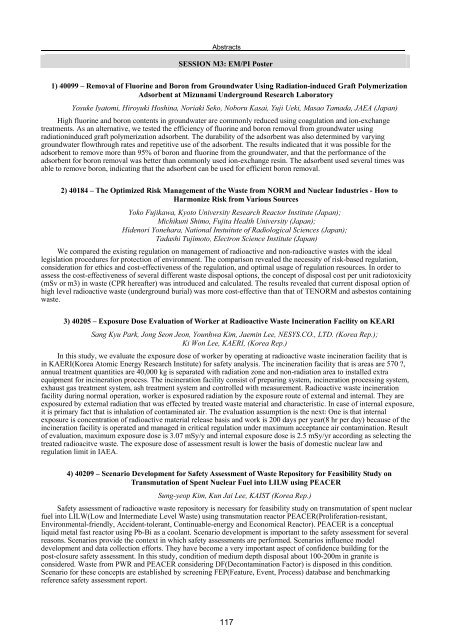The 13th International Conference on Environmental ... - Events
The 13th International Conference on Environmental ... - Events
The 13th International Conference on Environmental ... - Events
Create successful ePaper yourself
Turn your PDF publications into a flip-book with our unique Google optimized e-Paper software.
Abstracts<br />
SESSION M3: EM/PI Poster<br />
1) 40099 – Removal of Fluorine and Bor<strong>on</strong> from Groundwater Using Radiati<strong>on</strong>-induced Graft Polymerizati<strong>on</strong><br />
Adsorbent at Mizunami Underground Research Laboratory<br />
Yosuke Iyatomi, Hiroyuki Hoshina, Noriaki Seko, Noboru Kasai, Yuji Ueki, Masao Tamada, JAEA (Japan)<br />
High fluorine and bor<strong>on</strong> c<strong>on</strong>tents in groundwater are comm<strong>on</strong>ly reduced using coagulati<strong>on</strong> and i<strong>on</strong>-exchange<br />
treatments. As an alternative, we tested the efficiency of fluorine and bor<strong>on</strong> removal from groundwater using<br />
radiati<strong>on</strong>induced graft polymerizati<strong>on</strong> adsorbent. <str<strong>on</strong>g>The</str<strong>on</strong>g> durability of the adsorbent was also determined by varying<br />
groundwater flowthrough rates and repetitive use of the adsorbent. <str<strong>on</strong>g>The</str<strong>on</strong>g> results indicated that it was possible for the<br />
adsorbent to remove more than 95% of bor<strong>on</strong> and fluorine from the groundwater, and that the performance of the<br />
adsorbent for bor<strong>on</strong> removal was better than comm<strong>on</strong>ly used i<strong>on</strong>-exchange resin. <str<strong>on</strong>g>The</str<strong>on</strong>g> adsorbent used several times was<br />
able to remove bor<strong>on</strong>, indicating that the adsorbent can be used for efficient bor<strong>on</strong> removal.<br />
2) 40184 – <str<strong>on</strong>g>The</str<strong>on</strong>g> Optimized Risk Management of the Waste from NORM and Nuclear Industries - How to<br />
Harm<strong>on</strong>ize Risk from Various Sources<br />
Yoko Fujikawa, Kyoto University Research Reactor Institute (Japan);<br />
Michikuni Shimo, Fujita Health University (Japan);<br />
Hidenori Y<strong>on</strong>ehara, Nati<strong>on</strong>al Instuitute of Radiological Sciences (Japan);<br />
Tadashi Tujimoto, Electr<strong>on</strong> Science Institute (Japan)<br />
We compared the existing regulati<strong>on</strong> <strong>on</strong> management of radioactive and n<strong>on</strong>-radioactive wastes with the ideal<br />
legislati<strong>on</strong> procedures for protecti<strong>on</strong> of envir<strong>on</strong>ment. <str<strong>on</strong>g>The</str<strong>on</strong>g> comparis<strong>on</strong> revealed the necessity of risk-based regulati<strong>on</strong>,<br />
c<strong>on</strong>siderati<strong>on</strong> for ethics and cost-effectiveness of the regulati<strong>on</strong>, and optimal usage of regulati<strong>on</strong> resources. In order to<br />
assess the cost-effectiveness of several different waste disposal opti<strong>on</strong>s, the c<strong>on</strong>cept of disposal cost per unit radiotoxicity<br />
(mSv or m3) in waste (CPR hereafter) was introduced and calculated. <str<strong>on</strong>g>The</str<strong>on</strong>g> results revealed that current disposal opti<strong>on</strong> of<br />
high level radioactive waste (underground burial) was more cost-effective than that of TENORM and asbestos c<strong>on</strong>taining<br />
waste.<br />
3) 40205 – Exposure Dose Evaluati<strong>on</strong> of Worker at Radioactive Waste Incinerati<strong>on</strong> Facility <strong>on</strong> KEARI<br />
Sang Kyu Park, J<strong>on</strong>g Se<strong>on</strong> Je<strong>on</strong>, Younhwa Kim, Jaemin Lee, NESYS.CO., LTD. (Korea Rep.);<br />
Ki W<strong>on</strong> Lee, KAERI, (Korea Rep.)<br />
In this study, we evaluate the exposure dose of worker by operating at radioactive waste incinerati<strong>on</strong> facility that is<br />
in KAERI(Korea Atomic Energy Research Institute) for safety analysis. <str<strong>on</strong>g>The</str<strong>on</strong>g> incinerati<strong>on</strong> facility that is areas are 570 ?,<br />
annual treatment quantities are 40,000 kg is separated with radiati<strong>on</strong> z<strong>on</strong>e and n<strong>on</strong>-radiati<strong>on</strong> area to installed extra<br />
equipment for incinerati<strong>on</strong> process. <str<strong>on</strong>g>The</str<strong>on</strong>g> incinerati<strong>on</strong> facility c<strong>on</strong>sist of preparing system, incinerati<strong>on</strong> processing system,<br />
exhaust gas treatment system, ash treatment system and c<strong>on</strong>trolled with measurement. Radioactive waste incinerati<strong>on</strong><br />
facility during normal operati<strong>on</strong>, worker is exposured radiati<strong>on</strong> by the exposure route of external and internal. <str<strong>on</strong>g>The</str<strong>on</strong>g>y are<br />
exposured by external radiati<strong>on</strong> that was effected by treated waste material and characteristic. In case of internal exposure,<br />
it is primary fact that is inhalati<strong>on</strong> of c<strong>on</strong>taminated air. <str<strong>on</strong>g>The</str<strong>on</strong>g> evaluati<strong>on</strong> assumpti<strong>on</strong> is the next: One is that internal<br />
exposure is c<strong>on</strong>centrati<strong>on</strong> of radioactive material release basis and work is 200 days per year(8 hr per day) because of the<br />
incinerati<strong>on</strong> facility is operated and managed in critical regulati<strong>on</strong> under maximum acceptance air c<strong>on</strong>taminati<strong>on</strong>. Result<br />
of evaluati<strong>on</strong>, maximum exposure dose is 3.07 mSy/y and internal exposure dose is 2.5 mSy/yr according as selecting the<br />
treated radioacitve waste. <str<strong>on</strong>g>The</str<strong>on</strong>g> exposure dose of assessment result is lower the basis of domestic nuclear law and<br />
regulati<strong>on</strong> limit in IAEA.<br />
4) 40209 – Scenario Development for Safety Assessment of Waste Repository for Feasibility Study <strong>on</strong><br />
Transmutati<strong>on</strong> of Spent Nuclear Fuel into LILW using PEACER<br />
Sung-yeop Kim, Kun Jai Lee, KAIST (Korea Rep.)<br />
Safety assessment of radioactive waste repository is necessary for feasibility study <strong>on</strong> transmutati<strong>on</strong> of spent nuclear<br />
fuel into LILW(Low and Intermediate Level Waste) using transmutati<strong>on</strong> reactor PEACER(Proliferati<strong>on</strong>-resistant,<br />
Envir<strong>on</strong>mental-friendly, Accident-tolerant, C<strong>on</strong>tinuable-energy and Ec<strong>on</strong>omical Reactor). PEACER is a c<strong>on</strong>ceptual<br />
liquid metal fast reactor using Pb-Bi as a coolant. Scenario development is important to the safety assessment for several<br />
reas<strong>on</strong>s. Scenarios provide the c<strong>on</strong>text in which safety assessments are performed. Scenarios influence model<br />
development and data collecti<strong>on</strong> efforts. <str<strong>on</strong>g>The</str<strong>on</strong>g>y have become a very important aspect of c<strong>on</strong>fidence building for the<br />
post-closure safety assessment. In this study, c<strong>on</strong>diti<strong>on</strong> of medium depth disposal about 100-200m in granite is<br />
c<strong>on</strong>sidered. Waste from PWR and PEACER c<strong>on</strong>sidering DF(Dec<strong>on</strong>taminati<strong>on</strong> Factor) is disposed in this c<strong>on</strong>diti<strong>on</strong>.<br />
Scenario for these c<strong>on</strong>cepts are established by screening FEP(Feature, Event, Process) database and benchmarking<br />
reference safety assessment report.<br />
117
















